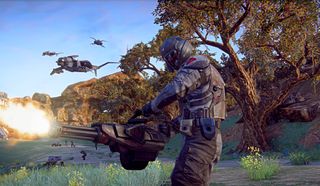We walked out of the spawn point and looked towards the objective. A few hundred yards away, dozens of soldiers were doing battle over a few scattered checkpoints inside of a large command base, blasting each other with heavy weapons and powerful vehicles. We decided to join them, taking to the sky in a light aircraft and swaying towards the battle. In only a few minutes, we’d become more comfortable with the air controls than we ever did with similar vehicles in Battlefield, and started engaging others in aerial dogfights.

As we destroyed one of our opponents and watched his debris tumble downward, we caught a glimpse of the battleground, and saw that our allies needed help. We didn’t choose a class that could survive a huge fall, though, so we’d need to attempt to jump ship near the ground. We did a flip in the aircraft and dove towards the dirt, pulling up at the last second and leaping to safety like something out of a Die Hard movie.
Yippie ki-yay.
It was daytime when the battle started, but by now, the sun had long set. This change is more than a cosmetic one – battling at night is much different than fighting during the day. Characters were harder to see, and muzzle flashes (which can be upgraded specifically to make them more difficult to see at night) gave away enemy locations much more than they did during the day. It’s a seemingly minor difference that completely changes the dynamics of the battlefield, making the warfare of Planetside 2 feel more alive than most FPS maps.
We used this cover of darkness to sneak around in the shadows, moving towards a small group of enemies. Before they saw us we tossed a grenade, firing our assault rifle before they had a chance to turn. Seconds later they were down, and we made our way towards the checkpoints.
Eventually we died on the battlefield – taken down by a nearby tank – and took a look at the map to see how the skirmish was going. The area we were in didn’t look that much different from a typical match of Tribes or Battlefield, but zooming out gave us a better view of the big picture. Planetside 2’s maps are massive, easily ten to twenty times the size of most FPS maps, with a three-front war pushing and pulling at persistent, capturable bases. There are no loadtimes between these areas, either, meaning you can walk from one side of the world to another (as long as no one kills you along the way). This battle rages on for an eternity, only restarting when the developers decree it necessary. Planetside 2 is, after all, an MMO, though it doesn’t use that as a shield. While the original Planetside was popular despite not being the strongest FPS, we feel like Planetside 2 is fun because it is such a good shooter.

Despite putting all of its chips into the FPS side of things, Sony Online Entertainment has still created a game that rewards players looking for an MMO. The range of customization is incredible, with each class, weapon, and vehicle having dozens of different upgrades to choose from. We scrolled through the lists rapidly, our eyes glazing over at the sheer number of possibilities. These options allow any player to specialize their role to their heart's content.
According to Tramell Isaac, Senior Art Director on Planetside 2, unlocking all of the upgrades would take players about three years – which, luckily, is around as far as Sony Online has planned for the future of the game. By the time that three-year point rolls around, the developer expects to have doubled the size of the game with new maps to expand on the launch's three, additional weapons, and more content to give players continued excuses to hit the battlefield.

In many ways, we left our hands-on time of Planetside 2 thinking that we had just seen the future of the FPS genre. The MMO side of things – fighting over territories and leveling up characters – was incredibly advanced, and the shooter underneath it all was as strong as any other FPS on the market. Even though it’s arguably one of the most technologically-advanced FPS in development, SOE decided to make it a free-to-play game, further assuring the longevity of the title by lowering the barrier of entry significantly.
Sony Online Entertainment may be paving the way for a new generation of games, and we’re looking forward to seeing how that future unfolds when the game releases later this year.

